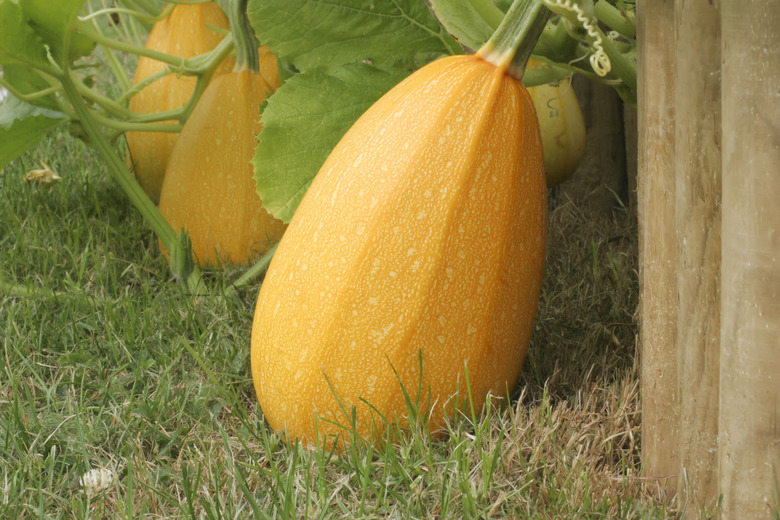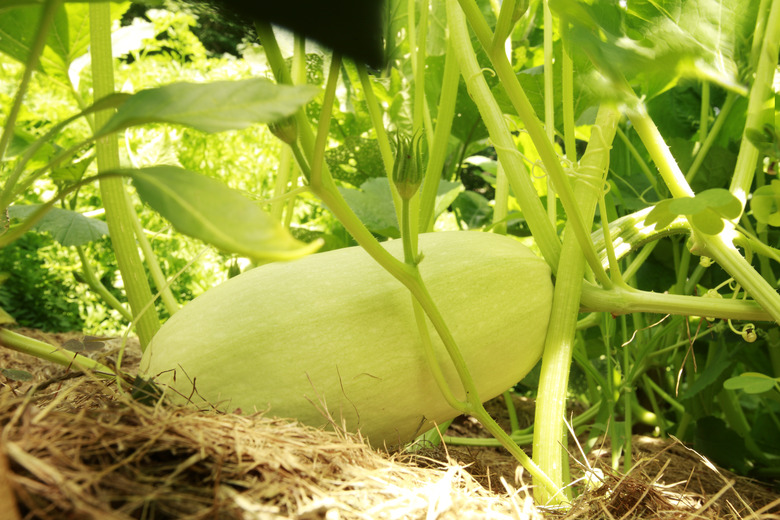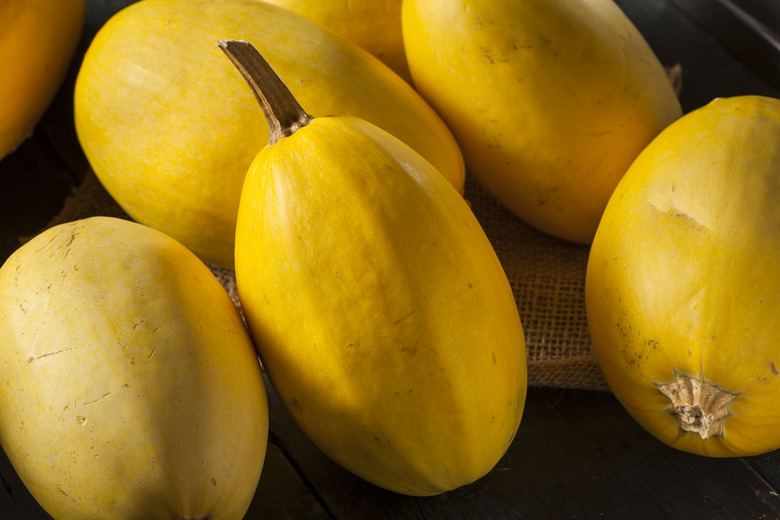How To Grow Spaghetti Squash
Spaghetti squash (Cucurbita pepo), like butternut squash, acorn squash, and other types of winter squash, is a member of the pumpkin family and differs from summer squash varieties like zucchini in an important way. Whereas you harvest summer squash before it matures — while the rind is still soft and edible — winter squash has to remain on the plant until the rind has hardened, which means harvest doesn't occur until late fall or early winter. The rind protects the fruit, which can be stored and eaten throughout the winter months.
Some types of winter squash, including pumpkins and acorn squash, are native to North America, but spaghetti squash is not. Its name might suggest Italian origins, but its first recorded use was in China in the early 1800s, and it came to North America via Japan in 1936. It took North Americans several years to appreciate the stringy consistency of its pulp, but when it became a substitute for real spaghetti during World War II, spaghetti squash became increasingly popular, and today, it's available at any supermarket or farmers market.
Like other varieties of squash, the spaghetti squash plant can be a vine or a bush, but the vine type is more common. It has large, heart-shaped leaves and produces yellow, trumpet-shaped flowers that precede the fruit, which is oblong, about 8 to 15 inches long, 4 to 5 inches around, and weighs about 2 or 3 pounds. The rind turns from green to yellow as the fruit matures, and when the squash is allowed to ripen fully, the rind and the stringy pulp inside are golden yellow.
Best Uses for Spaghetti Squash
Best Uses for Spaghetti Squash
Vining plants can be trained to grow up a trellis or a fence, but if left to their own devices, they will spread out to cover a fairly large part of the garden. One of the advantages of trellis growing is that it keeps the squash dry, although the heavy fruit does need to be supported in mesh bags. If you grow squash on the ground and the soil isn't well-drained, you should build a small hill for each plant to allow water to run off, or you could wind up with rotted fruit at harvest time.
Native Americans typically grow squash together with corn and beans, a combination known traditionally as the "three sisters," and while they plant other squash varieties, there's no reason not to do this with spaghetti squash. The corn is planted first and then the beans, which use the corn as climbing poles, and then the squash, which forms an effective weed-blocking ground cover. The beans fix nitrogen in the soil and provide nourishment for the corn and squash.
Squash has both male and female flowers, and they have to cross-pollinate to produce the best fruit. Bees are the main pollinators, so it's a good idea to grow flowers nearby to attract them, such as sunflowers, cosmos, or coneflowers.
How to Grow Spaghetti Squash
How to Grow Spaghetti Squash
Starting Spaghetti Squash From Seed
Starting Spaghetti Squash From Seed
You can sow spaghetti squash seeds outdoors directly in the garden if the growing season in your area is long enough, but in Northern zones, it may be necessary to start the seeds indoors. When starting seeds indoors, sow them in biodegradable containers that can be buried to avoid having to disturb the roots, which squash plants don't like. In cold weather, use grow lights to maintain the soil temperature at 60 degrees Fahrenheit and keep the soil moist, and the seeds should germinate in about 10 days.
When direct sowing in the garden, prepare a space in your vegetable garden by turning compost into the soil to a depth of 8 inches. If the soil drains slowly and you don't train the vines to climb, form hills 8 to 10 inches high and 3 to 6 feet wide, at the top of which you'll sow your seeds. Seeds should be spaced 36 inches apart and be buried 1 to 1 1/2 inches deep, and it's always a good idea to sow two or three seeds in the same place and thin the seedlings when they emerge to ensure successful germination. Covering the ground with mulch around each seed is a good idea because it helps keep the soil warm, and it provides a dry place for the developing squash to rest.
Starting Spaghetti Squash From a Seedling
Starting Spaghetti Squash From a Seedling
Transplant greenhouse-grown seedlings outdoors two weeks after all danger of frost has passed. The spaghetti squash plant gets large, especially when it grows as a bush, and it's somewhat unruly, so it needs plenty of room around it. Space bush-growing plants by at least 4 to 6 feet and vining plants by 2 to 4 feet, depending on the expected size of the fruit. If you train spaghetti squash vines to grow vertically, you can reduce the spacing between plants to 12 inches.
Water thoroughly and keep the soil moist. It's a good idea to protect the young plants with row covers to keep whiteflies and other insects away. Remove them as soon as the flowers appear so that pollinators can reach the flowers to pollinate them.
In What Zone Does Spaghetti Squash Grow Best?
In What Zone Does Spaghetti Squash Grow Best?
Spaghetti squash has a fairly long growing season. It is not frost tolerant and should be planted outdoors only when the temperature is 65 degrees or higher. It's easiest to meet these conditions in USDA plant hardiness zones 5 and warmer. In more Northern zones, starting the seeds indoors about a month before the last frost date is recommended so you can get them in the ground as soon as possible after all danger of frost has passed. If the ground hasn't warmed sufficiently by the end of May, the season is probably too short unless you grow a variety with a short growing season, which will likely be smaller than one with a long season.
When Should You Plant Spaghetti Squash?
When Should You Plant Spaghetti Squash?
The recommended time to plant spaghetti squash seeds or seedlings outdoors is two weeks after the last frost date, but the soil temperature must also be at least 65 degrees. In places where spring weather is unsettled and freak snowstorms are possible, cover the ground with plastic mulch to help warm the soil and protect the plants from unusual cold snaps.
You can plant spaghetti squash at intervals throughout the summer to produce a continuous harvest in the fall, but the last planting should be no less than about three months before the first expected frost date. Mature squash can tolerate one or two light frosts, which actually improve their flavor, but harvest spaghetti squash before the first hard frost sets in.
Soil, Sunlight, and Water Recommendations for Spaghetti Squash
Soil, Sunlight, and Water Recommendations for Spaghetti Squash
Spaghetti squash plants are large and need a lot of nutrients, so it's important to mix compost into the soil before planting. The ideal soil is loose and well drained, and it should be turned to a depth of at least 8 inches to make it loose enough for the roots to spread. Keep the soil moist while seeds are germinating and young plants are getting established, but once the flowers appear, water only if the rainfall is less than 1 to 2 inches a week. The plant thrives in full sun, and once the leaves develop, they'll provide enough shade to keep weeds from growing in the surrounding soil.
How to Propagate Spaghetti Squash
How to Propagate Spaghetti Squash
You can only grow spaghetti squash from seeds, and to ensure the plant has the characteristics you expect, you should purchase the seeds from a supplier. The squash plant must be cross-pollinated to produce fruit, and because bees do the work, the pollen may or may not come from flowers on the same plant. If you grow other squash species nearby, seeds harvested from your spaghetti squash may produce fruit with characteristics of the other species. If that's not important to you or you hand-pollinate the flowers, go ahead and collect seeds, dry them, and plant them the following year.
How to Harvest Spaghetti Squash
How to Harvest Spaghetti Squash
It's essential to leave spaghetti squash on the vine until it's fully ripe because it won't ripen once you cut it. The squash gradually turns a deeper shade of yellow as the season progresses, and it's ready when the color is almost golden and the skin is shiny and hard enough to resist being punctured by your fingernail. At this point, cut the stem with a knife or shears, leaving about an inch of stem on the fruit. Spaghetti squash will keep for up to three months when stored in a cool, dry place.
Common Pests and Other Problems for Spaghetti Squash
Common Pests and Other Problems for Spaghetti Squash
Like all squash plants, spaghetti squash is plagued by a host of garden pests, not the least of which are two hungry interlopers with the word "squash" right in their names. Some of these pests work out in the open and are big enough to pick off by hand, while others hide under leaves and in the ground and are recognizable only by the damage they do. Using row covers while the squash plants are young helps exclude some bugs, while others can be controlled with insecticidal soap. Some of the pests you might spot in your veggie garden include:
- Squash bugs, which are shield-shaped, beetle-like bugs that cause speckled, wilted, or yellow leaves and can damage or destroy the fruit. Pick them off, use insecticidal soap, and destroy plants immediately after harvest.
- Squash vine borer larvae tunnel into the base of the stem and cause the plant to wilt or die. Look for holes lined with insect excrement, cut into the stem, and remove the larvae. Plow the crop deep into the soil immediately after harvest.
- Cucumber beetles are yellow with black spots or bands, and they cause extensive damage to leaves, stems, and fruit. Protect preflowering plants with row covers and use a garden-safe insecticide if necessary.
Common Diseases for Spaghetti Squash
Common Diseases for Spaghetti Squash
Pathogens that attack spaghetti squash plants can be fungal, bacterial, or viral, and they can be carried by insects, transmitted through the soil, or spread by nearby weeds. Fungal diseases such as septoria leaf spot and powdery mildew often occur in cool, wet conditions or when plants are overcrowded, and you can help prevent them by thinning leaves to provide more air circulation.
Other diseases, such as cercospora leaf spot, fusarium root rot, and verticillium wilt, are caused by fungi that live in the soil. The most effective prevention is good garden maintenance and crop rotation. A fungicide sometimes helps eradicate existing cases, although it's best used as a preventive; carefully read and follow all label directions.
Bacterial wilt is caused by a pathogenic bacterium, and squash mosaic is a virus. Both are spread by cucumber beetles, while aster yellows is caused by a phytoplasma carried by leafhoppers, so controlling insects is doubly important because it helps control diseases.


